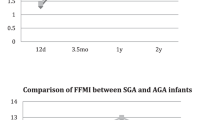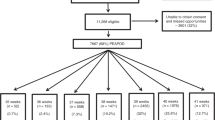Abstract
Background/Objectives:
Previous anthropometry-based studies have suggested that in Indian newborns fat mass is conserved at the expense of lean tissue. This study was undertaken to assess the body composition of Indian newborns and to evaluate its relation with parents’ anthropometry, birth weight and early postnatal weight gain.
Subjects/Methods:
Body composition of healthy term singleton newborns was assessed by the deuterium dilution method in the second week of life. Anthropometry was carried out at birth and on the day of study.
Results:
Data from 127 babies were analyzed. Birth weight was 2969±383 g. Body composition was assessed at a mean age of 12.7±3.1 days. Fat and fat-free mass were 354±246 and 2764±402 g, respectively, and fat mass percentage (FM%) was 11.3±7.3%. Birth weight and fat-free mass were higher among boys, but no gender difference was noted in FM%. Birth weight was positively correlated with fat as well as fat-free mass but not FM%. FM% showed positive correlation with gain in weight from birth to the day of assessment.
Conclusions:
This is the first study from India to report body composition in newborns using deuterium dilution. FM% was comparable to that reported for Western populations for babies of similar age. Our results suggest that the percentage of fat and fat-free mass is relatively constant over the range of birth weights included in this study, and greater weight gain during early postnatal period results in greater increase in FM%.
This is a preview of subscription content, access via your institution
Access options
Subscribe to this journal
Receive 12 print issues and online access
$259.00 per year
only $21.58 per issue
Buy this article
- Purchase on Springer Link
- Instant access to full article PDF
Prices may be subject to local taxes which are calculated during checkout

Similar content being viewed by others
References
Yajnik CS, Fall CH, Coyaji KJ, Hirve SS, Rao S, Barker DJ et al. Neonatal anthropometry: the thin-fat Indian baby. The Pune Maternal Nutrition Study. Int J Obes Relat Metab Disord 2003; 27: 173–180.
Krishnaveni GV, Hill JC, Veena SR, Leary SD, Saperia J, Chachyamma KJ et al. Truncal adiposity is present at birth and in early childhood in South Indian children. Indian Pediatr 2005; 42: 527–538.
Wells JC . Body composition in infants: evidence for developmental programming and techniques for measurement. Rev Endocr Metab Disord 2012; 13: 93–101.
Singhal A, Lucas A . Early origins of cardiovascular disease: is there a unifying hypothesis? Lancet 2004; 363: 1642–1645.
Jain V, Singhal A . Catch up growth in low birth weight infants: striking a healthy balance. Rev Endocr Metab Disord 2012; 13: 141–147.
Khandelwal P, Jain V, Gupta AK, Kalaivani M, Paul VK . Association of early postnatal growth trajectory with body composition in term low birth weight infants. J Dev Orig Health Dis 2014; 5: 189–196.
Demerath EW, Fields DA . Body composition assessment in the infant. Am J Hum Biol 2014; 26: 291–304.
de Bruin NC, van Velthoven KA, Stijnen T, Juttmann RE, Degenhart HJ, Visser HK . Body fat and fat-free mass in infants: new and classic anthropometric indexes and prediction equations compared with total-body electrical conductivity. Am J Clin Nutr 1995; 61: 1195–1205.
Kabir N, Forsum E . Estimation of total body fat and subcutaneous adipose tissue in full-term infants less than 3 months old. Pediatr Res 1993; 34: 448–454.
Kulkarni B, Mamidi RS, Balakrishna N, Radhakrishna KV . Body composition assessment in infancy and early childhood: comparison of anthropometry with dual-energy X-ray absorptiometry in low-income group children from India. Eur J Clin Nutr 2014; 68: 658–663.
Wells JC, Fewtrell MS, Davies PS, Williams JE, Coward WA, Cole TJ . Prediction of total body water in infants and children. Arch Dis Child 2005; 90: 965–971.
Ward LC, Poston L, Godfrey KM, Koletzko B . Assessing early growth and adiposity: report from an Early Nutrition Academy workshop. Ann Nutr Metab 2013; 63: 120–130.
Schoeller D . Hydrometry. In: Heymsfield S, Lohman T, Wang Z (eds). Human Body Composition: Human Kinetics, 2nd ed. Champaign, IL, USA, 2005, pp 35–50.
Wells JC, Cole TJ, Davies PS . Total energy expenditure and body composition in early infancy. Arch Dis Child 1996; 75: 423–426.
Schoeller D, Kushner R, Taylor P, Dietz WH, Bandini L . Measurement of total body water: isotope dilution techniques. In: Roche AF (ed). Body Composition Assessments in Youth and Adults. Sixth Ross Conferences on Medical Research: Columbus, OH, USA, 1985, pp 124–129.
Chomtho S, Wells JC, Davies PS, Lucas A, Fewtrell MS . Early growth and body composition in infancy. Adv Exp Med Biol 2009; 646: 165–168.
Wells JC . A Hattori chart analysis of body mass index in infants and children. Int J Obes Relat Metab Disord 2000; 24: 325–329.
Davies PS, Wells JC . Calculation of total body water in infancy. Eur J Clin Nutr 1994; 48: 490–495.
Wells JC, Hawton K, Darch T, Lunn PG . Body composition by 2H dilution in Gambian infants: comparison with UK infants and evaluation of simple prediction methods. Br J Nutr 2009; 102: 1776–1782.
Rosendale RP, Bartok CJ . Air-displacement plethysmography for the measurement of body composition in children aged 6-48 months. Pediatr Res. 2012; 71: 299–304.
Butte NF, Hopkinson JM, Wong WW, Smith EO, Ellis KJ . Body composition during the first 2 years of life: an updated reference. Pediatr Res 2000; 47: 578–585.
Eriksson B, Lof M, Eriksson O, Hannestad U, Forsum E . Fat-free mass hydration in newborns: assessment and implications for body composition studies. Acta Paediatr 2011; 100: 680–686.
Andersen GS, Girma T, Wells JC, Kæstel P, Michaelsen KF, Friis H . Fat and fat-free mass at birth: air displacement plethysmography measurements on 350 Ethiopian newborns. Pediatr Res. 2011; 70: 501–506.
Nielsen SB, Wells JC, Slater C, Fewtrell MS, Reilly JJ . Administering labeled water to exclusively breast-fed infants in studies involving stable isotope dilution techniques. Isotopes Environ Health Stud 2011; 47: 18–25.
Wang Z, Shen W, Withers R, Hemysfield S . Multicomponent molecular-level models of body composition analysis. In: Hemysfield S, Lohman T, Wang Z (eds). Human body composition: Human Kinetics, 2nd ed. Champaign, IL, USA, 2005, pp 163–176.
Ma G, Yao M, Liu Y, Lin A, Zou H, Urlando A et al. Validation of a new pediatric air-displacement plethysmograph for assessing body composition in infants. Am J Clin Nutr. 2004; 79: 653–660.
Au CP, Raynes-Greenow CH, Turner RM, Carberry AE, Jeffery H . Fetal and maternal factors associated with neonatal adiposity as measured by air displacement plethysmography: a large cross-sectional study. Early Hum Dev 2013; 89: 839–843.
Venkataraman PS, Ahluwalia BW . Total bone mineral content and body composition by x-ray densitometry in newborns. Pediatrics 1992; 90: 767–770.
Hashimoto K, Wong WW, Thomas AJ, Uvena-Celebrezze J, Huston-Pressley L, Amini SB et al. Estimation of neonatal body composition: isotope dilution versus total-body electrical conductivity. Biol Neonate 2002; 81: 170–175.
Harrod CS, Chasan-Taber L, Reynolds RM, Fingerlin TE, Glueck DH, Brinton JT et al. Physical activity in pregnancy and neonatal body composition: the Healthy Start study. Obstet Gynecol 2014; 124: 257–264.
Carberry AE, Colditz PB, Lingwood BE . Body composition from birth to 4.5 months in infants born to non-obese women. Pediatr Res 2010; 68: 84–88.
Friis CM, Qvigstad E, Paasche Roland MC, Godang K, Voldner N, Bollerslev J et al. Newborn body fat: associations with maternal metabolic state and placental size. PLoS One 2013; 8: e57467.
Ahmad I, Nemet D, Eliakim A, Koeppel R, Grochow D, Coussens M et al. Body composition and its components in preterm and term newborns: a cross-sectional, multi-modal investigation. Am J Hum Biol 2010; 22: 69–75.
Fields DA, Gilchrist JM, Catalano PM, Giannì ML, Roggero PM, Mosca F . Longitudinal body composition data in exclusively breast-fed infants: a multicenter study. Obesity 2011; 19: 1887–1891.
Eriksson B, Löf M, Forsum E . Body composition in full-term healthy infants measured with air displacement plethysmography at 1 and 12 weeks of age. Acta Paediatr 2010; 99: 563–568.
Muthayya S, Dwarkanath P, Thomas T, Vaz M, Mhaskar A, Mhaskar R et al. Anthropometry and body composition of south Indian babies at birth. Public Health Nutr 2006; 9: 896–903.
Modi N, Thomas EL, Uthaya SN, Umranikar S, Bell JD, Yajnik C . Whole body magnetic resonance imaging of healthy newborn infants demonstrates increased central adiposity in Asian Indians. Pediatr Res 2009; 65: 584–587.
Catalano PM, Kirwan JP . Maternal factors that determine neonatal size and body fat. Curr Diab Rep 2001; 1: 71–77.
Lukaszewski MA, Eberlé D, Vieau D, Breton C . Nutritional manipulations in the perinatal period program adipose tissue in offspring. Am J Physiol Endocrinol Metab 2013; 305: e1195–e1207.
Olhager E, Flinke E, Hannerstad U, Forsum E . Studies on human body composition during the first 4 months of life using magnetic resonance imaging and isotope dilution. Pediatr Res 2003; 54: 906–912.
Harrington TA, Thomas EL, Frost G, Modi N, Bell JD . Distribution of adipose tissue in the newborn. Pediatr Res 2004; 55: 437–441.
IndexMundi. Weight of the world: Average body mass index values for adults around the globe. 2013. Available from http://www.indexmundi.com/blog/wp-content/uploads/2013/04/weight-of-the-world.jpg.
Veena SR, Krishnaveni GV, Wills AK, Hill JC, Fall CH . A principal components approach to parent-to-newborn body composition associations in South India. BMC Pediatr 2009; 9: 16.
Fall CH, Sachdev HS, Osmond C, Lakshmy R, Biswas SD, Prabhakaran D et al. Adult metabolic syndrome and impaired glucose tolerance are associated with different patterns of BMI gain during infancy: Data from the New Delhi Birth Cohort. Diabetes Care 2008; 31: 2349–2356.
Acknowledgements
We acknowledge the financial support from Department of Biotechnology, Ministry of Science and Technology, Government of India, for this study. The assistance from project staff, Ms Sapna Khatak, Mr Anuj Kumar and Mr Naveen Kumar is also acknowledged.
Author information
Authors and Affiliations
Corresponding author
Ethics declarations
Competing interests
The authors declare no conflict of interest.
Rights and permissions
About this article
Cite this article
Jain, V., Kurpad, A., Kumar, B. et al. Body composition of term healthy Indian newborns. Eur J Clin Nutr 70, 488–493 (2016). https://doi.org/10.1038/ejcn.2015.152
Received:
Revised:
Accepted:
Published:
Issue Date:
DOI: https://doi.org/10.1038/ejcn.2015.152
This article is cited by
-
Development and validation of anthropometric-based fat-mass prediction equations using air displacement plethysmography in Mexican infants
European Journal of Clinical Nutrition (2023)
-
Body composition from birth to 2 years in term healthy Indian infants measured by deuterium dilution: Effect of being born small for gestational age and early catch-up growth
European Journal of Clinical Nutrition (2022)
-
Mid-upper arm circumference in pregnant women and birth weight in newborns as substitute for skinfold thickness: findings from the MAASTHI cohort study, India
BMC Pregnancy and Childbirth (2021)



